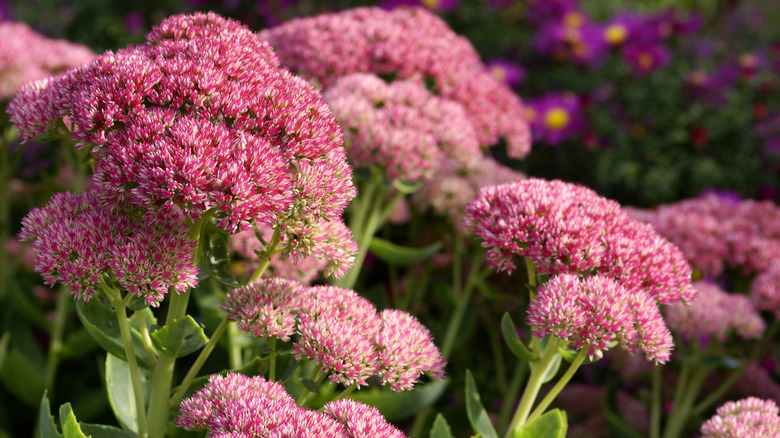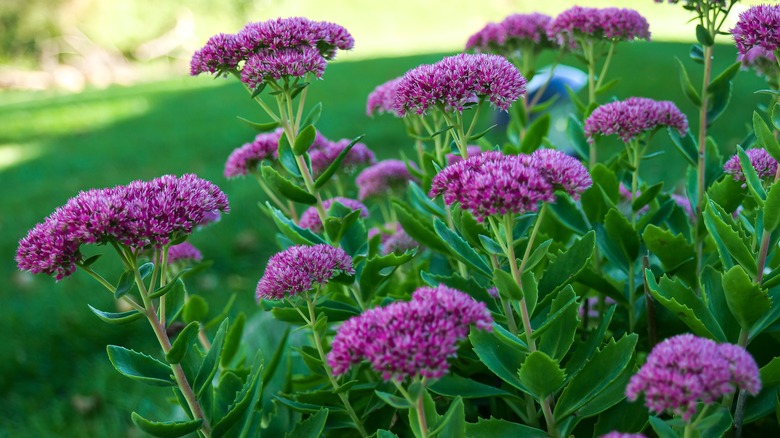Lavender is a top choice for many gardens with its vibrant violet florals and fragrant scent that attract all our favorite pollinators. Deciding what to plant next to specific crops and flowers around your home can be challenging, as you want to ensure they will make good companions and won’t interfere with any neighboring growth. Even armed with everything you need to know for planting lavender, you can find a great companion to plant alongside it this spring: sedum.
As part of the Crassulaceae plant family, sedum features succulent-like foliage with waxy, thick leaves and stems that boast colorful clusters of flowers in stellate forms. It is a unique combination of what we love about our succulents with the perks of still seeing delicate flowers bloom each season. Also known as stonecrop, it has over 400 species (some annuals and some perennials) and is native to the Northern Hemisphere. They grow exceptionally well in dry and sunny environments, just like lavender. Between the two plants’ similar growing conditions, similar care needs, and balanced coloration, you’ll find excellent companionship between sedum and lavender in your garden.
Pairing sedum with lavender

Sedum has two main varieties to consider planting in your garden: upright and creeping. Upright sedum is much like it sounds, consisting of tall, vertical stems holding flower clusters. Creeping, on the other hand, grows low to the ground and spreads out horizontally. Regardless of the type you choose to plant, all sedums will pair exceptionally well with lavender. Their growing conditions and care needs are very similar, requiring little extra work than what you already routinely perform for lavender. Sedum prefers full sunlight, loamy and well-draining soils, and grows best in USDA zones 3 to 10.
Additionally, sedum blooms after lavender has already surpassed its peak season, allowing portions of your garden that have both plants to continue showcasing vibrant color well into autumn. The vertical purple flowers produced by lavender will be the perfect counterpart to the pink and white pigments and grouped florals that sedum offers. Sedum and lavender make a great combination for garden boarders with their drought tolerance, especially around plants that deer and rabbits like to nibble on. Neither plant is appetizing to these pests that wander about your property and will work well to prevent damage in your garden. Although sedum prefers full sunlight, it can withstand semi-shaded locations and is a good filler for empty shaded spots where lavender cannot grow. This is just one example of how companion planting can benefit your garden.
Growing sedum

As you contemplate heading to the nursery and purchasing some sedum plugs for your garden, be prepared to plant them in the springtime after the last frost has occurred but before the extreme heat of summer commences. Ideally, you’ll want to grow sedum in a location with six hours of daily sunlight and well-aerated soil. As you transfer the plant from the nursery pot into the ground, the hole’s depth should be just deep enough for the rootball to be even with the ground’s surface. While your new sedum is settling in and adapting to its new location, you can water sparingly once a week. However, once the plant matures, it won’t need scheduled watering, and average rainfall will do the trick. Any sitting water will be detrimental to the plant’s health, and fertilizer doesn’t make much of a difference in its growth trajectory and can do more harm than good.
Some popular varieties to consider pairing with your lavender or simply featuring in your garden include ‘Autumn Joy,’ ‘White Stonecrop,’ and ‘Brilliant.’ ‘Autumn Joy’ is an upright sedum variety with baby pink flowers that turn an orangish hue along with the leaves as fall approaches. It is one of the most commonly grown types of sedum. ‘White Stonecrop’ grows low to the ground with a reddish tint to its star-like white blossoms. ‘Brilliant’ is an upright variety loved by many for its unique hot pink coloration, and its blooming season can last up to six months.



